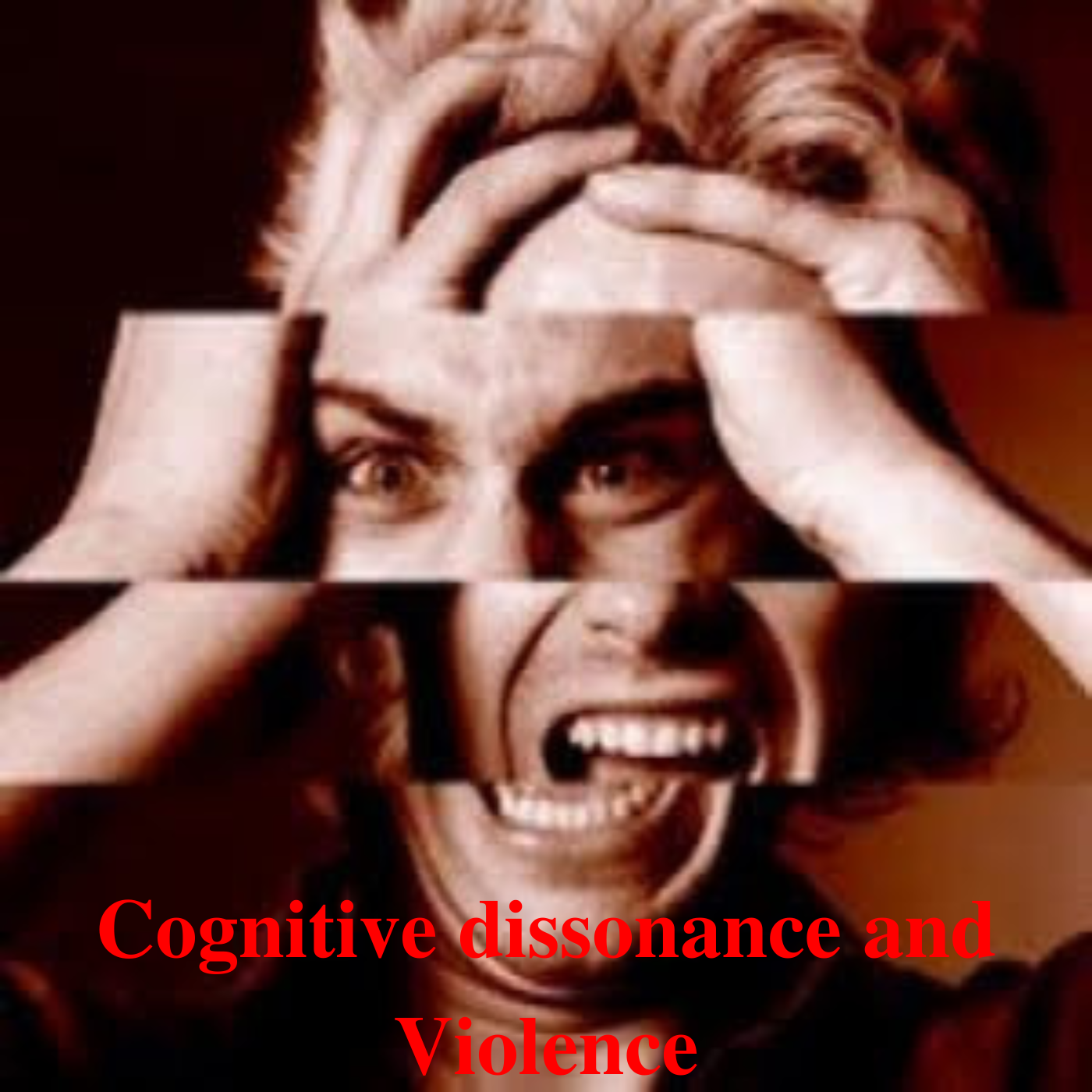
Cognitive dissonance and Violence. I am immensely gratified by the positive feedback received for my new eBook, "Kyusho Jitsu and the Vagus Nerve." It is encouraging to see that individuals are becoming more aware of the importance of proactive self-defense measures. While ego can serve as a protective mechanism, in many instances, it has been overly nurtured to the point of detriment.
Today, the streets in Western regions pose significant risks, marking a stark contrast from past conditions.
A notable factor contributing to the escalation of danger is the prevalence of mental illness, which has reached unprecedented levels. This surge is often attributed to a psychological phenomenon known as "Cognitive Dissonance." Now we will explore Cognitive dissonance and Violence.
Cognitive dissonance and Violence
Below is some information on "Cognitive Dissonance."
** Cognitive Dissonance is a psychological concept introduced by Leon Festinger in 1957. It describes the discomfort experienced when an individual holds two or more contradictory beliefs, ideas, or values at the same time, or is confronted by new information that conflicts with existing beliefs, ideals, or values. This tension leads individuals to engage in psychological strategies to reduce the dissonance and achieve a state of harmony or consonance in their thoughts and beliefs.
In the context of societal issues, cognitive dissonance can manifest in various ways, such as denial or rationalization when confronted with evidence that challenges deeply held beliefs. It plays a significant role in how individuals interact with information and make decisions, impacting behaviors on a personal and collective level. Understanding and addressing cognitive dissonance is crucial in fields ranging from psychology and education to marketing and conflict resolution, offering insights into human behavior and the complexities of the human mind.**
Cognitive dissonance and Violence
The link between cognitive dissonance and extreme or violent behavior can be understood through several psychological mechanisms. When individuals face cognitive dissonance—that is, the conflict between their deeply held beliefs and contradictory evidence or experiences—they may resort to extreme measures to resolve this discomfort. Here's an expanded explanation of how cognitive dissonance can lead to violent behavior in extreme cases: Cognitive dissonance and Violence is a real thing, forget the lies of the media.
1) Defense Mechanisms: In an effort to protect their self-concept and reduce the discomfort of dissonance, individuals may employ defense mechanisms such as denial, projection, or aggression. These mechanisms can distort reality or shift blame to others, leading to hostility or violence against perceived threats or sources of contradiction.
2) Identity and Group Affiliation: Cognitive dissonance can be particularly intense when it involves beliefs central to an individual's identity or their affiliation with specific groups. When individuals perceive their beliefs or those of their group to be under attack, they may resort to violence as a means of defending their identity or asserting their beliefs against opposing viewpoints. See the link here between Cognitive dissonance and Violence?
3) Escalation of Commitment: Once individuals have engaged in a course of action or publicly committed to a belief, admitting error or changing course can cause significant cognitive dissonance. To avoid the discomfort of admitting wrong, individuals may escalate their commitment to a belief or action, even to the point of engaging in violent behavior to prove their commitment or correctness.
4) Rationalization and Justification: Individuals experiencing cognitive dissonance may rationalize or justify extreme or violent actions as necessary for achieving a greater good or defending against a perceived evil. This rationalization process allows them to align their actions with their beliefs, reducing dissonance but potentially leading to harm against others.
5) Echo Chambers and Radicalization: In the digital age, echo chambers and online communities can exacerbate cognitive dissonance by reinforcing narrow viewpoints and presenting contradictory information as threats to group identity. This environment can accelerate radicalization processes, where individuals adopt increasingly extreme beliefs and justify violence as a means of addressing perceived injustices or conflicts. Facebook and others because of their censoring are enabling Cognitive dissonance and Violence.
6) Psychological Distress and Aggression: The psychological distress caused by unresolved cognitive dissonance can lead to increased aggression and impulsivity. In extreme cases, this may manifest as violent behavior if the individual sees no other way to alleviate the tension or feels cornered by their cognitive conflicts.
Cognitive dissonance and Violence
Understanding the link between cognitive dissonance and violent behavior highlights the importance of strategies for effectively managing dissonance, such as promoting open dialogue, critical thinking, and empathy. These approaches can help individuals navigate conflicting beliefs without resorting to extremism or violence, fostering a more tolerant and peaceful society.
With all this in mind, the role of the media and its associated misconduct in fostering "Cognitive Dissonance" and perpetuating extreme viewpoints presents a critical issue for society. This phenomenon has tangible repercussions on the streets of both the Americas and Western Europe. The so-called "powers that be" have shown a reluctance, or perhaps an inability, to tackle this issue effectively. This hesitancy can be attributed to a prevailing lack of competence, which seems to be the norm rather than the exception today. Thus Cognitive dissonance and Violence run free and unchecked.
Given the heightened level of danger and the significant changes we face in our world today, I felt compelled to author the eBook titled “Kyusho Jitsu and the Vagus Nerve.” This book delves into the critical intersection of self-defense techniques and the physiological impact they can have, particularly through the Vagus nerve. Below is a synopsis of the functions of the Vagus nerve to provide further context.
The Vagus nerve, also known as the tenth cranial nerve, plays a crucial role in the body's autonomic nervous system, essentially acting as a communication highway between the brain and several vital organs. Its functions are vast and varied, including but not limited to:
- Heart Rate Regulation: The Vagus nerve sends signals to the heart to decrease heart rate, helping to manage stress responses and promote calmness.
- Digestive Processes: It stimulates muscles in the stomach to contract and propel food through the digestive tract, aiding in digestion and nutrient absorption.
- Inflammatory Response: The Vagus nerve has a significant role in controlling inflammation by releasing neurotransmitters that can reduce the body's inflammatory response.
- Respiratory Rate: It affects the muscles involved in breathing, contributing to the regulation of respiratory rate and depth.
- Communication Between the Brain and Gut: The Vagus nerve is a key component of the gut-brain axis, allowing for the exchange of chemical messages that influence mood, anxiety, and immune function.
- Reflex Actions: Such as coughing, sneezing, and swallowing, which are crucial for protecting the respiratory tract and aiding in the ingestion of food.
Understanding the Vagus nerve's functions offers profound insights into how targeted techniques, such as those discussed in “Kyusho Jitsu and the Vagus Nerve,” can influence the body's physiological and psychological responses, providing a unique approach to self-defense and overall well-being.
Given the increasingly dangerous world we inhabit, I felt compelled to author the eBook "Kyusho Jitsu and the Vagus Nerve." The Vagus nerve, with its extensive influence throughout the body, plays a pivotal role in our physiological and psychological responses. Its functions range from regulating heart rate, digestion, and immune response to impacting mood and stress levels. Understanding its functions offers profound insights into holistic self-defense techniques.
With this understanding, activating, striking, or manipulating specific pressure points associated with the Vagus nerve can have significant effects on an assailant, particularly one in an "extreme mental state," such as the anger that can stem from Cognitive Dissonance. An illustrative example of such a pressure point is ST-09, located at the Carotid Sinus Reflex.
Targeting this area can induce a blackout or even a severe cardiac event by causing a sudden decrease in blood pressure. This is just one example of how knowledge of the Vagus nerve's related pressure points can be applied in self-defense, offering a way to neutralize threats effectively and efficiently in association with Cognitive dissonance and Violence.
Cognitive dissonance and Violence in Conclusion

My new eBook, "Kyusho Jitsu and the Vagus Nerve," goes beyond merely listing pressure points associated with the Vagus nerve; it crucially explains how to access these points during an assault by someone in a violent, uncontrollable state. Traditional defense techniques often fall short in such scenarios, underscoring the importance of specialized knowledge and strategies to ensure one's safety effectively.
This guide offers invaluable insights into harnessing the power of the Vagus nerve to neutralize threats in extreme situations, like Cognitive dissonance and Violence. A potential solution for a time when Cognitive dissonance and Violence come into your life.
Cognitive dissonance, coupled with violence, presents a significant challenge on the streets of Western societies today. This reality underscores the necessity for all of us to be prepared for potential encounters.
Embracing the adage that change favors the prepared mind, it is imperative to understand both the complexities of cognitive dissonance and the violence it can incite, as well as the strategies for effectively managing these challenges.
Thank you for taking time out of your day to read this articled called Cognitive dissonance and Violence.
Questions?
Do you have questions on Cognitive dissonance and Violence. Use the form below to ask.
If you found this article on Cognitive dissonance and Violence to be of value to you please consider subscribing to NEW articles using the Red Bell at the bottom corner of this blog.
Have a wonderful day!
Yours in the arts,
Grand Master Art Mason
